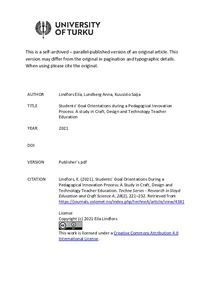Students’ Goal Orientations during a Pedagogical Innovation Process : A study in Craft, Design and Technology Teacher Education
Lindfors Eila; Lundberg Anna; Kuusisto Saija
https://urn.fi/URN:NBN:fi-fe2021120158366
Tiivistelmä
Learning goal orientation profiles are used to describe an individual’s general attitudes and expectations of their performance. Students with strong goal orientation focus on the task itself, rather than on how their performance will affect themselves or their surroundings. This study aims to understand factors linked to students’ goal orientation during a pedagogical innovation process (PIP). The research material was gathered in the Craft, Design and Technology (CDT) education teacher training programme of a Finnish university. The data consisted of learning diaries (N=22) written by student teachers who, in their learning assignment, had to find a solution to an authentic problem: to design and manufacture an artefact aimed at assisting the teaching of CDT.
The results of this study indicate that the students with a high level of goal orientation experienced many beneficial factors whereas students with a low level of goal orientation experienced many disadvantageous factors during the PIP. According to the results, factors lowering goal orientation seem to be linked to students’ attitudes and study skills or to their experience of unclear instructions. The factors improving goal orientation were the possibility of learning new things and an opportunity to influence their work. The theory-driven content analysis opened up a new way of categorising the factors for students’ personal work and group work, as well as the factors related to learning assignments and teaching arrangements. According to this study, education should be organised in way that students find explicit and interesting. By understanding the factors behind the formation of learning goal orientation, teachers will be able to influence students in a way that benefits learning.
Kokoelmat
- Rinnakkaistallenteet [19250]
